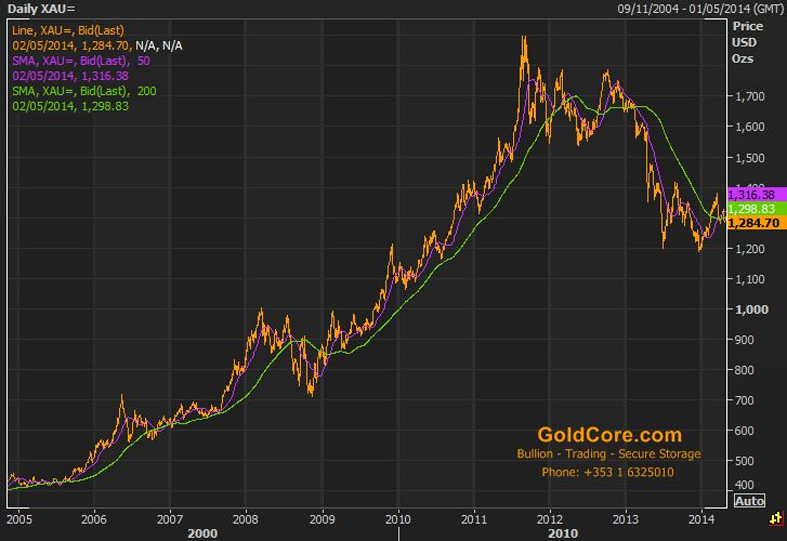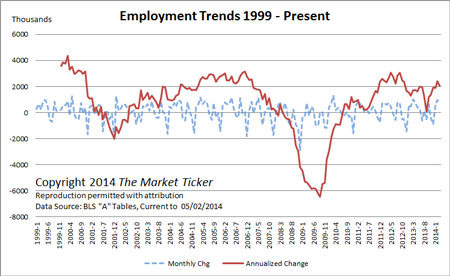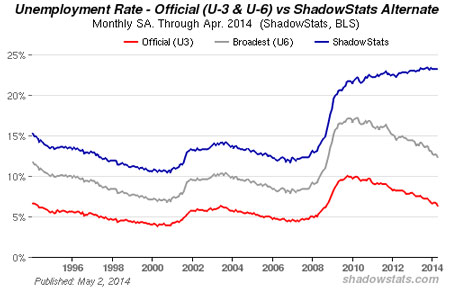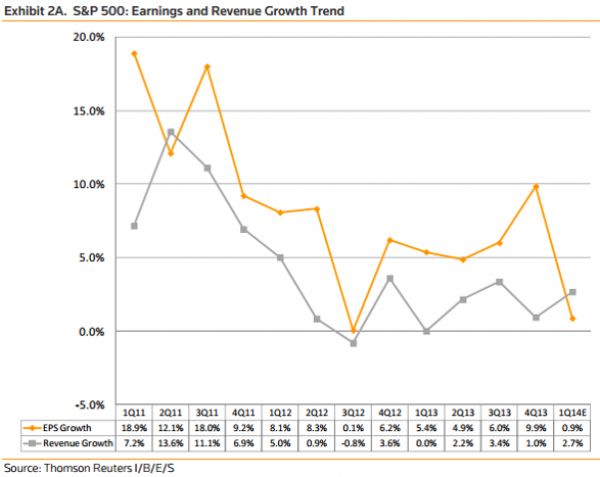by
GoldCore
Today’s AM fix was USD 1,285.00, EUR 927.26
and GBP 761.03 per ounce.
Yesterday’s AM fix was USD 1,283.00,
EUR 924.15 and GBP 759.04 per ounce.
Gold fell $5.50 or 0.43% yesterday to
$1,284.90/oz. Silver slipped $0.13 or 0.68% yesterday to $19.06/oz.
Please
note GoldCore
is closed for a Bank Holiday, this Monday, May 5th, reopening May
6th.
Gold remained in range bound trading yesterday
and into this morning, fluctuating between $1,280 and $1,285/oz.
Likewise, silver traded in a narrow band between $18.90 and
$19.10/oz. The precious metals appear to be treading water while
awaiting the open of New York morning trading, and the release of the
latest U.S. non-farm payroll figures today.
Consensus payroll data estimates from surveyed
economists indicate improving expectations for April and a possible
drop in the unemployment rate. Any surprises in the U.S. payroll data
today could be the catalyst to move the gold price out of its very
narrow trading pattern, although given that it’s the end of the
trading week, the short term direction for gold may not become
apparent until next week.

Gold
in USD Simple Moving Averages, 9 Years – (Thomson Reuters)
Italy
May Have Over 1,000 Tonnes Of Gold At The New York Fed
Written by
Ronan Manly for GoldCore
Italy’s
central bank, the Banca d’Italia, has recently published an
important document detailing the storage locations and composition of
the country’s gold reserves. The document confirms that Italy’s
gold is held across four vault locations, three of which are outside
Italy.
This is a significant announcement given that
the Banca d’Italia is the world’s third largest official holder
of gold after the U.S. and Germany. Italy officially holds 2,451.8
tonnes of gold, worth more than €72 billion (US$ 100 billion) at
current market prices [1].
In the detailed three page report focusing
exclusively on its gold reserves (and only published in Italian), the
Banca d’Italia reveals that 1,199.4 tonnes, or nearly half the
total, is held in the Bank’s own vaults under its Palazzo Koch
headquarters on Via Nazionale in Rome, while most of the other half
is stored in the Federal Reserve Bank gold vault in New York. The
report also states that smaller amounts are stored at the Bank of
England in London, and at the vaults of the Swiss National Bank in
Bern, Switzerland.
The
Gold in RomeOf
the 1,199.4 tonnes held in Rome, 1,195.3 tonnes are in the form of
gold bars, with 4.1 tonnes held as gold coins (871,713 coins). There
are 95,493 bars in the Rome vault, most of which are the standard
trapezoidal shaped bars, however the holdings also include brick
shaped U.S. Assay Office bars produced by the U.S. Assay Office, and
another bar type which the Bank d’Italia refers to as ‘panetto’
(or loaf) shaped ‘English’ bars.
Like other major European central banks, the
Banca d’Italia’s gold reserves were mainly accumulated during the
late 1950s and early 1960s. Although Italy was already an important
official gold holder during the first half of the 20th century, it
still only held 402 tonnes of gold as of 1957. However, from 1958
until the late 1960s, the country’s gold reserves increased nearly
600% to exceed 2,560 tonnes by 1970[2].
Since 1970, Italy’s gold holdings have
remained fairly constant, although at times some of the gold has been
used in various financial transactions such as gold collateral
against a German loan during the 1970s, and as contributions to the
European Monetary Cooperation Fund (EMCF) and more recently to the
European Central Bank (ECB).
The
RAI Broadcast, the BIS and BernWhile
the report from the Banca d’Italia appears to be the first official
written confirmation that documents the exact storage sites of its
gold reserves, the four storage locations were previously confirmed
to Italian TV station RAI in 2010 when an RAI presenter and crew were
allowed to film a report from inside the Bank’s gold vaults in
Rome.
In the RAI broadcast for an episode of
‘Passaggio a Nord Ovest’, the presenter Alberto Angela states
that in addition to Rome, the Italian gold is stored at the Federal
Reserve Bank in New York, the Bank of England in London, and at the
Bank for International Settlements (BIS) in Switzerland. The reporter
uses the exact words “Banca dei Regolamenti Internazionali”.
The BIS connection was also confirmed in August
2009, when Italian newspaper “La Repubblica” published an article
about Italy’s gold, stating that it was held in Rome, at the
Federal Reserve in New York, in the vaults of the the Bank of
England, and in the ‘vaults’ of the BIS in Basel.
This apparent contradiction between, on the one
hand, the RAI and La Repubblica, who both state that some of the
Italian gold is stored with the BIS in Switzerland, and on the other
hand, the Banca d’Italia’s own document which states that its
gold in Switzerland is stored at the Swiss National Bank (SNB) in
Bern, is not really a contradiction since the BIS does not have its
own gold storage facilities in Switzerland. The BIS simply uses the
SNB’s gold vaults in Bern.
The BIS confirms this fact on its web site,
under foreign exchange and gold services, where it states that it
offers its clients “safekeeping and settlements facilities
available loco London, Bern or New York”.[3] The term loco refers
to settlement location for precious metals transactions.
By confirming that it stores gold at the Swiss
National Bank in Bern, the Banca d’Italia has also inadvertently
confirmed that the Swiss National Bank’s gold vaults are located in
Bern. While this was generally known, the SNB currently will not
confirm this fact publically and does not go beyond saying that it
stores its own gold “domestically and internationally” in
“decentralised” locations.[4]
However, Bern based Swiss newspaper “Der
Bund” published an article in 2008 stating that the SNB’s gold
vaults are in Bern, specifically underneath the Bundesplatz square
which is adjacent to the SNB’s headquarters at No. 1 Bundsplatz.
The SNB has two headquarters, one in Bern, the other in Zurich.
So it appears that the Italian gold in
Switzerland is on deposit with the BIS (either earmarked or as a
sight deposit) and is, at the same time, stored in Bern at the SNB
vaults. Therefore the RAI and La Repubblica reports and the Banca
d’Italia report are most likely both all in agreement, since they
are merely saying the same thing, just in different ways. Another
possibility is that the BIS sight deposit was converted back to
earmarked gold in the SNB vault sometime since the 2010 RAI
broadcast.
The reason for the confusion is because the
Banca d’Italia will not confirm any of these details about how
their gold in Bern is held, and they stated last week that they
cannot comment beyond what is published in their April document.
Some of the details in the Bank’s gold
reserve document were also confirmed a week prior to its publication
when three Italian senators from Beppe Grillo’s political party
Movimento 5 Stelle (Five Star Movement), namely, the party treasurer
Giuseppe Vacciano, Andrea Cioffi and Francesco Molinari, visited the
Rome vault on 31st March 2014.
The senators’ report states that as well as
the 1,199.4 tonnes of gold held in Rome, “the remainder is mostly
deposited at the Federal Reserve”, but also at the Bank of England
and at “la Banca Centrale Svizzera” (which is the Swiss National
Bank). The senators also reported that “For confidentiality reasons
we were not notified of the exact extent of the deposits in different
countries”.
Italian
Gold in New YorkAs
per the senators’ experience, the Banca d’Italia document does
not specify how much of the Italian gold is held in New York, London
and Bern, beyond stating that most of the gold that is not stored in
Rome is stored in New York. However, the document does state that
“the bulk” of foreign stored gold is in New York with
“contingents of smaller size” located in London and Bern, so
essentially it implies that the London and Bern holdings are not very
large.
Of the 1,252.4 tonnes not in Rome, technically,
a majority of this figure is anything greater than 626.2 tonnes. So
with a simple calculation, there is at least 626.2 tonnes of Italian
gold in New York. But given that the “bulk” of 1,252.4
tonnes is in New York as the Bank’s document implies, and that
“most of the remainder” not in Rome is in New York as the
senator’s comments imply, then there could be anywhere up to
between 1,000 tonnes and 1,200 tonnes of Italian gold in the FRB in
New York.
In fact, 522 tonnes of this Italian gold that
was earmarked at the Federal Reserve in New York in September 1974
was used as gold collateral for the Bundesbank loan to Italy during
the first gold loan to Italy between 1974 and 1976. This collateral
rose to 543 tonnes between 1976 and 1978.
London
– The Bank of EnglandIt
is possible using historical data and records of Italian gold
movements to estimate how much, or how little, Italian gold may be in
London.
It would appear that the Banca d’Italia does
not hold very large amounts of gold in London. During the late 1960s,
mainly between 1966 and 1968, the Banca d’Italia moved most of
their gold that was stored at the Bank of England back to Italy.
Regular shipments were exported and delivered to the Bank’s vaults
in both Rome and Milan. By the end of 1969, the Banca d’Italia held
less than 1,000 gold bars in London, or just under 400,000 ounces
(approx. 12 tons).
Therefore, since Italian gold reserves have not
in total changed very much since 1969, it would be realistic to
assume that the Banca d’Italia’s London gold holdings have not
changed very much since 1969, unless gold was moved back to London
(or swapped back to London) after 1969. This would only make sense if
it had been moved back to London for a specific reason such as to
allow Italian gold lending through the London market. Gold lending
only really began in London in the mid-1980s, and there is no public
record that the Italians have engaged in gold lending through London.
Bern,
SwitzerlandHistorical
records from the BIS show that there wasn’t any Italian gold left
in Bern after WWII, so whatever Italian balance is in Bern has been
built up since 1946. It’s interesting to note that Sweden and
Finland both recently published the international locations of their
gold reserves, and revealed that only very small percentages of their
gold is kept in the SNB vaults in Switzerland. Of Sweden’s 125.7
tonnes of gold reserves, only 2.8 tonnes or 2.2% is stored with the
SNB vaults[5]. For Finland, only 7%, or 3.4 tonnes of its 49 tonnes
of gold reserves are stored with the SNB in Switzerland[6].
If this Swedish-Finnish 2-7% range of
allocations at the SNB was applied to the Italian gold that is
reported to be outside Italy, it would work out at between 25 tonnes
and 87.6 tonnes of Italian gold held at the SNB vaults in Bern.
Assuming that there is very little Italian gold in London (400,000ozs
or about 12 tonnes), and only a small allocation in Bern, then there
could be nearly 1,200 tonnes of Italian gold at the Federal Reserve
in New York.
Gold
Audits and RepatriationThe
Banca d’Italia state in their gold document that external auditors
verify the gold held in Rome each year in conjunction with the Bank’s
own internal auditors. The external auditors also verify the gold
held abroad using annual certificates issued by the central banks
that act as the depositories i.e.
This sound very similar to the way the German
gold reserves stored abroad was audited. i.e. the gold stored abroad
is not physically audited at all (although the Bundesbank did
describe recently in quite a vague way that their gold in New York
was recently audited by some of their own appointed representatives).
Given the widespread recent media coverage of
the German Bundesbank’s plans to repatriate 300 tonnes of its gold
reserves from the Federal Reserve in New York to the Bundesbank’s
headquarters in Frankfurt, it will be interesting to see whether, in
time, a critical mass is reached in Italian public opinion or even in
Italian political opinion that would lead to the Banca d’Italia
raising a similar request to the Federal Reserve.
The fact that the initial gold repatriated from
New York by the Bundesbank needed to be melted down and recast
(suggesting that it was low grade coin bars), does not inspire
confidence that the Banca d’Italia might not face a similar problem
if it attempts any gold repatriation from New York.
[1]
Excluding the IMF, Italy is the world’s third largest official gold
holder; including the IMF, Italy is the world’s fourth largest gold
holder.
[2] Central Bank Gold Reserves, An Historical perspective
since 1845, Timothy Green, Research Study No. 23, November 1999, WGC
Click Here to for GoldCore’s Essential Guide
for Storing Gold in Singapore
















